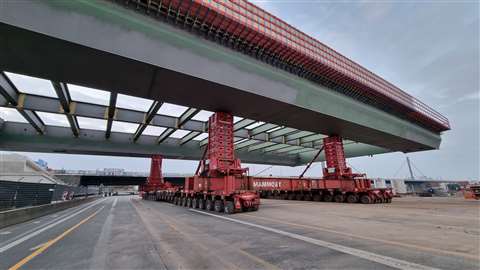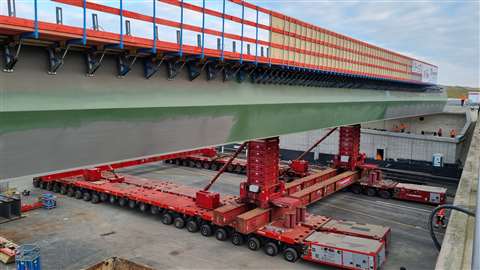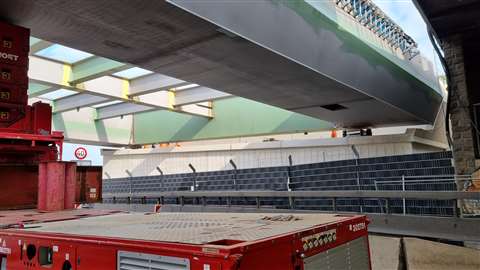Mammoet moves entire bridge section
21 June 2022
SEH Engineering contracted Mammoet to move a new bridge section of the Rhine Bridge, in Leverkusen in Germany, 300 metres to its installation position.
 The bridge section weighed 1,100 tonnes (Photo: Mammoet)
The bridge section weighed 1,100 tonnes (Photo: Mammoet)
As the bridge section weighed 1,100 tonnes, and was 66 metres by 34 metres, the highway had to be fully closed.
The new bridge aims to increase traffic volumes on the highway with its new 8 lane structure.
Mammoet used several of its Mega Jack 500 systems, gantry girders and three units of 24 axle lines of self propelled modular transporter (SPMT).
Engineering moves
The simplest approach – stacking the bridge section on the abutment benches using climbing jacks – could not be used because the bridge has a slope in both its the longitudinal and transverse directions.
This would mean the abutment benches would be both at an angle and at different end heights.
 Four towers of Mammoet’s Mega Jack 500 system were used for the job (Photo: Mammoet)
Four towers of Mammoet’s Mega Jack 500 system were used for the job (Photo: Mammoet)
This approach would also require a longer road closure, so the engineering teams worked together to develop a different solution.
Mammoet’s method was to lift, transport and set down the bridge section, all in one manoeuvre.
Four towers of the Mega Jack 500 system were used. The equipment lifted the load via the insertion of successive cassettes at ground level, which reduced manual handling and the need to work at height.
Accessibility issues
Due to a hole in the ground at the pre-assembly site, the bridge section was not accessible to the SPMT.
 Mammoet used three units of 24 axle lines of SPMT for the transport (Photo: Mammoet)
Mammoet used three units of 24 axle lines of SPMT for the transport (Photo: Mammoet)
The hole was needed for a pillar of the bypass bridge. Instead of filling and covering the hole, it was more efficient to slightly change the position of the bridge section.
So, Mammoet’s team moved the bridge section one metre just before execution.
The repositioned bridge segment was then lifted with four climbing jacks so that the SPMT could be driven underneath.
The gantry girders and Mega Jack 500 towers were then erected on the SPMT.
The bridge section was manoeuvred 300 metres across the confined site to the installation location, then lifted several metres further so that it could be driven over the abutments of different heights, before being lowered and installed.
Bridge bottlenecks
 The bridge section was manoeuvred 300 metres across the confined site to the installation location (Photo: Mammoet)
The bridge section was manoeuvred 300 metres across the confined site to the installation location (Photo: Mammoet)
The new replacement Rhine bridge in Leverkusen is one of the largest infrastructure construction projects in North Rhine-Westphalia.
It is scheduled for completion at the end of 2023 and aims to eliminate traffic bottlenecks.





